Versions Compared
Key
- This line was added.
- This line was removed.
- Formatting was changed.
Overview
This guide shows the main components of the TE0802 module and introduces the first steps to get the provided reference design up and running.
This module TE00802 has a Xilinx Zynq Ultrascale+ and several hardware features onboard that allows you to create digital hardware and software designs. For communication and configuration the module board offers a JTAG/UART Interface.
| Scroll Title | ||||||||||||||||||||||||
|---|---|---|---|---|---|---|---|---|---|---|---|---|---|---|---|---|---|---|---|---|---|---|---|---|
| ||||||||||||||||||||||||
|
Prerequisites
| Hardware | Software |
|---|---|
|
|
Documentation
- Official links to the shop:
- Technical Reference Manual:
- Resources & Reference Designs:
Hardware Features and Overview
| Expand | ||||||||||||||||||||||||
|---|---|---|---|---|---|---|---|---|---|---|---|---|---|---|---|---|---|---|---|---|---|---|---|---|
| ||||||||||||||||||||||||
| ||||||||||||||||||||||||
| Scroll Title | ||||||||||||||||||||||
|---|---|---|---|---|---|---|---|---|---|---|---|---|---|---|---|---|---|---|---|---|---|---|
| ||||||||||||||||||||||
|
| Info |
|---|
Information on IO routing and FPGA pin connections can be found in the |
Reference Design - Introduction
| Scroll Ignore | ||||||||||||||
|---|---|---|---|---|---|---|---|---|---|---|---|---|---|---|
| ||||||||||||||
| Page properties | ||||
|---|---|---|---|---|
| ||||
ACHTUNG!!! Hier soll noch entschieden werden, ob hier nur kurz auf das Referenzdesign eingegangen wird und die Inhalte im public doc - test board Beschreibung rein genommen werden bzw ... was hier überhaupt noch sinnvoll reingehört ? |
The provided reference design "TE0802 test board" we are introducing in this Getting started guide interacts with most of the peripheral on the module. It shows as an example how to connect the different parts of the module to simplify the development of your own application. You can use it for your own design but keep in mind the overall FPGA resources and power consumption before deployment. The most important steps to get it up and running from the scratch are explained on TE0802 Test Board. The Download is available here.
An overview of the components used in this reference design is illustrated in the following figure:
| Scroll Title | ||||||
|---|---|---|---|---|---|---|
| ||||||
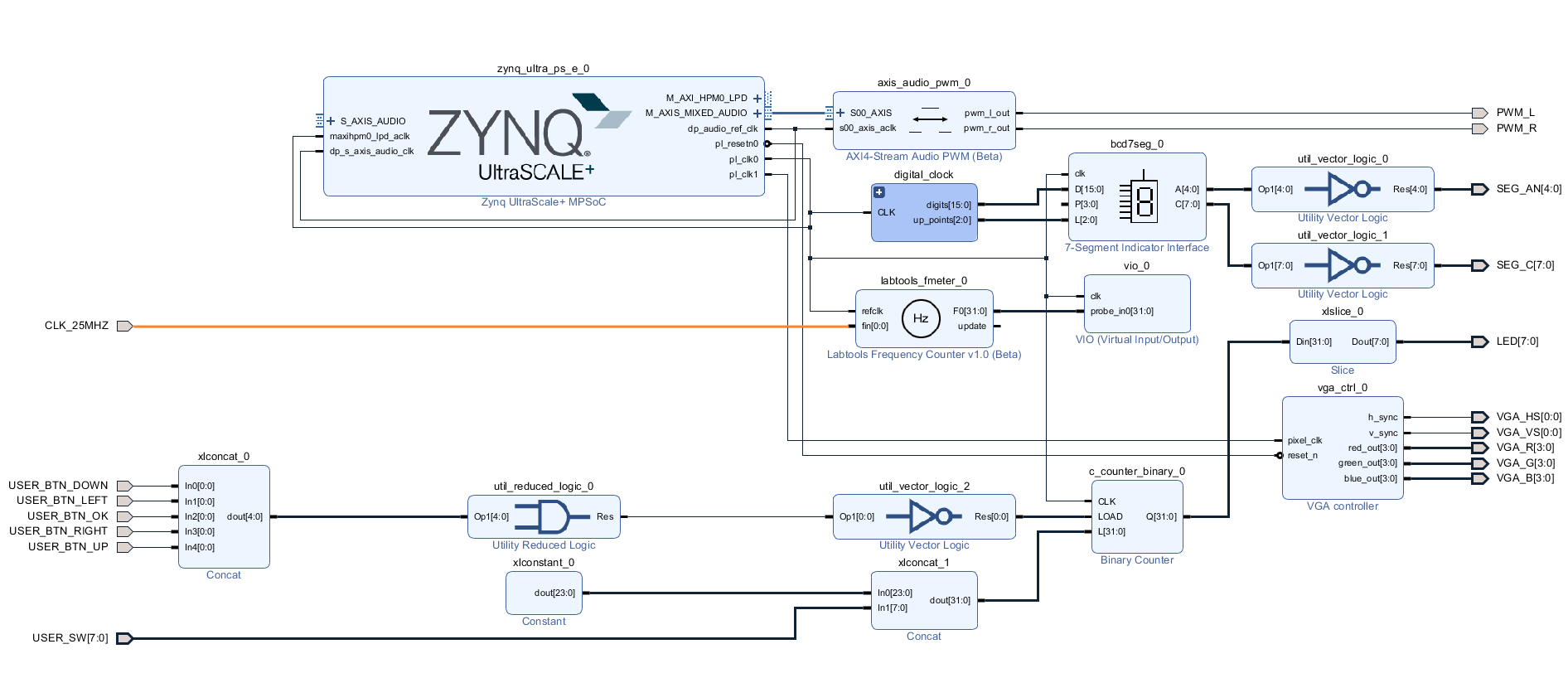 |
Hardware Setup and Power up in QSPI-Boot mode
| Scroll Ignore | ||||||||||||||
|---|---|---|---|---|---|---|---|---|---|---|---|---|---|---|
| ||||||||||||||
Preparations
- Download the source code and configuration files for "TE0802 test_board" reference design. Ensure that your download files match your Vivado version.
Check the settings from DIP-Switch S1 (JTAG):
S1.1 S1.2 S1.3 S1.4 OFF OFF OFF OFF Run _create_win_setup.cmd/_create_linux_setup.sh and follow instructions on shell:
Code Block language bash theme Midnight title _create_win_setup.cmd/_create_linux_setup.sh ------------------------Set design paths---------------------------- -- Run Design with: _create_win_setup -- Use Design Path: <absolute project path> -------------------------------------------------------------------- -------------------------TE Reference Design--------------------------- -------------------------------------------------------------------- -- (0) Module selection guide, project creation...prebuilt export... -- (1) Create minimum setup of CMD-Files and exit Batch -- (2) Create maximum setup of CMD-Files and exit Batch -- (3) (internal only) Dev -- (4) (internal only) Prod -- (c) Go to CMD-File Generation (Manual setup) -- (d) Go to Documentation (Web Documentation) -- (g) Install Board Files from Xilinx Board Store (beta) -- (a) Start design with unsupported Vivado Version (beta) -- (x) Exit Batch (nothing is done!) ---- Select (ex.:'0' for module selection guide):
- Press '0' and enter to start "Module Selection Guide"
- Select your assembly version
- validate selection
- press '2' and enter to "create Vivado project" and "create and open delivery binary folder"
- Depending on the preferred application, continue with chapter "Linux in QSPI-Boot mode" or "'Hello Trenz' in QSPI-Boot mode"
Linux in QSPI-Boot mode
- Connect the MicroUSB cable from your module board with your PC
- Connect peripherals to devices
- VGA, display port → monitor
- USB → keyboard
- ...
- Connect the module board with the power supply (5V)
- Power on module board
Program 'u-boot' application on QSPI flash
Code Block language bash theme Midnight title run on Vivado TCL (Script programs BOOT.bin on QSPI flash) TE::pr_program_flash -swapp u-boot
- Power off module board
- Copy image.ub, init.sh and boot.scr on SD card (e.g. <project folder>\test_board\_binaries_TE0802-02-2AEV2-A\boot_linux)
Switch the DIP-Switch S1 to QSPI-Boot mode
S1.1 S1.2 S1.3 S1.4 ON OFF OFF OFF - Insert the SD card into the module board
Power on the module board
In case the QSPI Flash is loaded with the reference design, you can connect to the board with a program like PuTTY. Just open up a serial session with baudrate of 115200 and the right COM port (visible in Device Manager).
Scroll Title anchor Figure_VHM title-alignment center title Terminal example 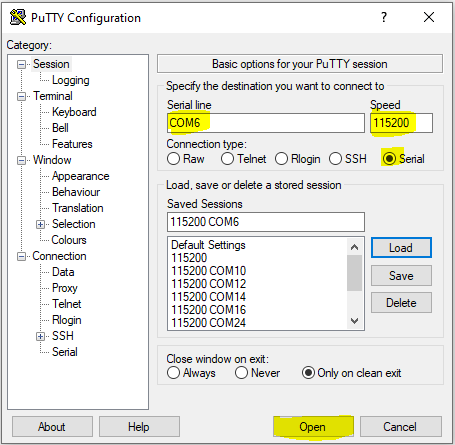
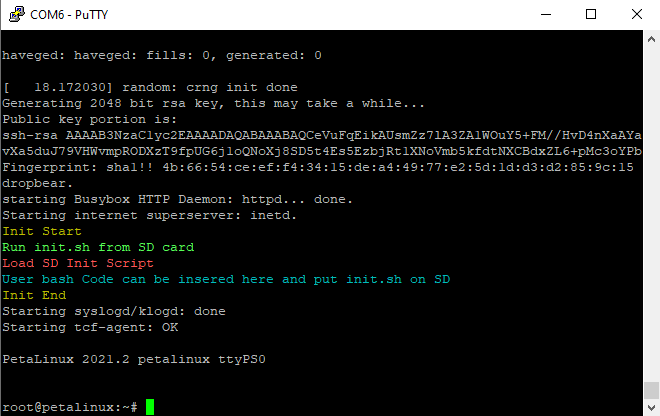
Boot process
Zynq Boot ROM loads FSBL from QSPI into OCM,
- FSBL init PS, programs PL using the bitstream and loads U-boot from QSPI into DDR,
- U-boot loads Linux (image.ub) from SD into DDR
- For usage instructions please refer to chapter Linux application
'Hello Trenz' in QSPI-Boot mode
- Connect the MicroUSB cable from your module board with your PC
Connect the module board with the power supply (5V)
Power on module board
Program 'hello_te0802' application on QSPI flash
Code Block language bash theme Midnight title run on Vivado TCL (Script programs BOOT.bin on QSPI flash) TE::pr_program_flash -swapp hello_te0802
Switch the DIP-Switch S1 to QSPI-Boot mode:
S1.1 S1.2 S1.3 S1.4 ON OFF OFF OFF Restart the module board
In case the QSPI Flash is loaded with the reference design, you can connect to the board with a program like PuTTY. Just open up a serial session with baudrate of 115200 and the right COM-port (visible in Device Manager).
Scroll Title anchor Figure_VHM title-alignment center title Terminal example 
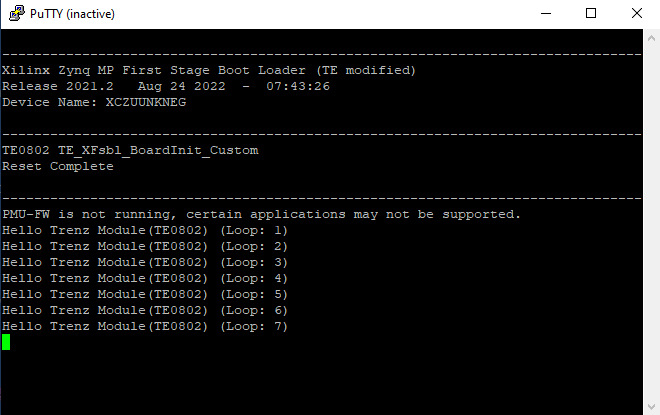
Hardware Setup and Power up in SD-Boot mode
| Scroll Ignore | ||||||||||||||
|---|---|---|---|---|---|---|---|---|---|---|---|---|---|---|
| ||||||||||||||
Linux in SD-Boot mode
- Download the source code and configuration files for "TE0802 test_board" reference design. Ensure that your download files match your Vivado version.
Run _create_win_setup.cmd/_create_linux_setup.sh and follow instructions on shell:
Code Block language bash theme Midnight title _create_win_setup.cmd/_create_linux_setup.sh ------------------------Set design paths---------------------------- -- Run Design with: _create_win_setup -- Use Design Path: <absolute project path> -------------------------------------------------------------------- -------------------------TE Reference Design--------------------------- -------------------------------------------------------------------- -- (0) Module selection guide, project creation...prebuilt export... -- (1) Create minimum setup of CMD-Files and exit Batch -- (2) Create maximum setup of CMD-Files and exit Batch -- (3) (internal only) Dev -- (4) (internal only) Prod -- (c) Go to CMD-File Generation (Manual setup) -- (d) Go to Documentation (Web Documentation) -- (g) Install Board Files from Xilinx Board Store (beta) -- (a) Start design with unsupported Vivado Version (beta) -- (x) Exit Batch (nothing is done!) ---- Select (ex.:'0' for module selection guide):
- Press '0' and enter to start "Module Selection Guide"
- Select your assembly version
- validate selection
- press '1' and enter to "create and open delivery binary folder"
- Connect the MicroUSB cable from your module board with your PC
- Connect peripherals to devices
- VGA, display port → monitor
- USB → keyboard
- ...
- Connect the module board with the power supply (5V)
- Copy BOOT.bin, image.ub, init.sh and boot.scr on SD card (e.g. <project folder>\test_board\_binaries_TE0802-02-2AEV2-A\boot_linux)
Switch the DIP-Switch S1 to SD-Boot mode
S1.1 S1.2 S1.3 S1.4 ON ON OFF OFF - Insert the SD card into the module board
Power on the module board
You can connect to the board with a program like PuTTY. Just open up a serial session with baudrate of 115200 and the right COM port (visible in Device Manager).
Scroll Title anchor Figure_VHM title-alignment center title Terminal example 

Boot process
Zynq Boot ROM loads FSBL from SD into OCM,
- FSBL init PS, programs PL using the bitstream and loads U-boot from SD into DDR,
- U-boot loads Linux (image.ub) from SD into DDR
- For usage instructions please refer to chapter Linux application
Linux Application
| Scroll Ignore | ||||||||||||||
|---|---|---|---|---|---|---|---|---|---|---|---|---|---|---|
| ||||||||||||||
After the Linux boot is complete, you can use the Linux shell and the connected peripherals
I2C
| Code Block | ||||||
|---|---|---|---|---|---|---|
| ||||||
i2cdetect -l (Shows a list of the available I2C buses) i2cdetect -y -r 1 (check I2C 1 Bus) |
Real Time Clock (RTC)
| Code Block | ||||||
|---|---|---|---|---|---|---|
| ||||||
dmesg | grep rtc (RTC check) hwclock --test |
Ethernet
| Code Block | ||||||
|---|---|---|---|---|---|---|
| ||||||
udhcpc (ETH0 check) ifconfig (shows the configuration of the network interface) |
USB
| Code Block | ||||||
|---|---|---|---|---|---|---|
| ||||||
lsusb (USB check) |
PCIe (M.2 SSD)
| Code Block | ||||||
|---|---|---|---|---|---|---|
| ||||||
lspci (PCIe check) |
Audio
| Code Block | ||||||
|---|---|---|---|---|---|---|
| ||||||
aplay /<link to mounted sd card>/<filename>.wav (e.g. aplay /run/mount/sd/<filename>.wav) |
| Info |
|---|
|
VGA
- connect VGA to monitor and adjust source (it shows test pattern)
Display Port
- second linux console output will be shown on the monitor, when boot process is finished.
- connect keyboard to TE0802 USB, to interact with the second console
- petalinux login: root
- password: root
Webserver
Expand title insert IP on web browser to start web interface 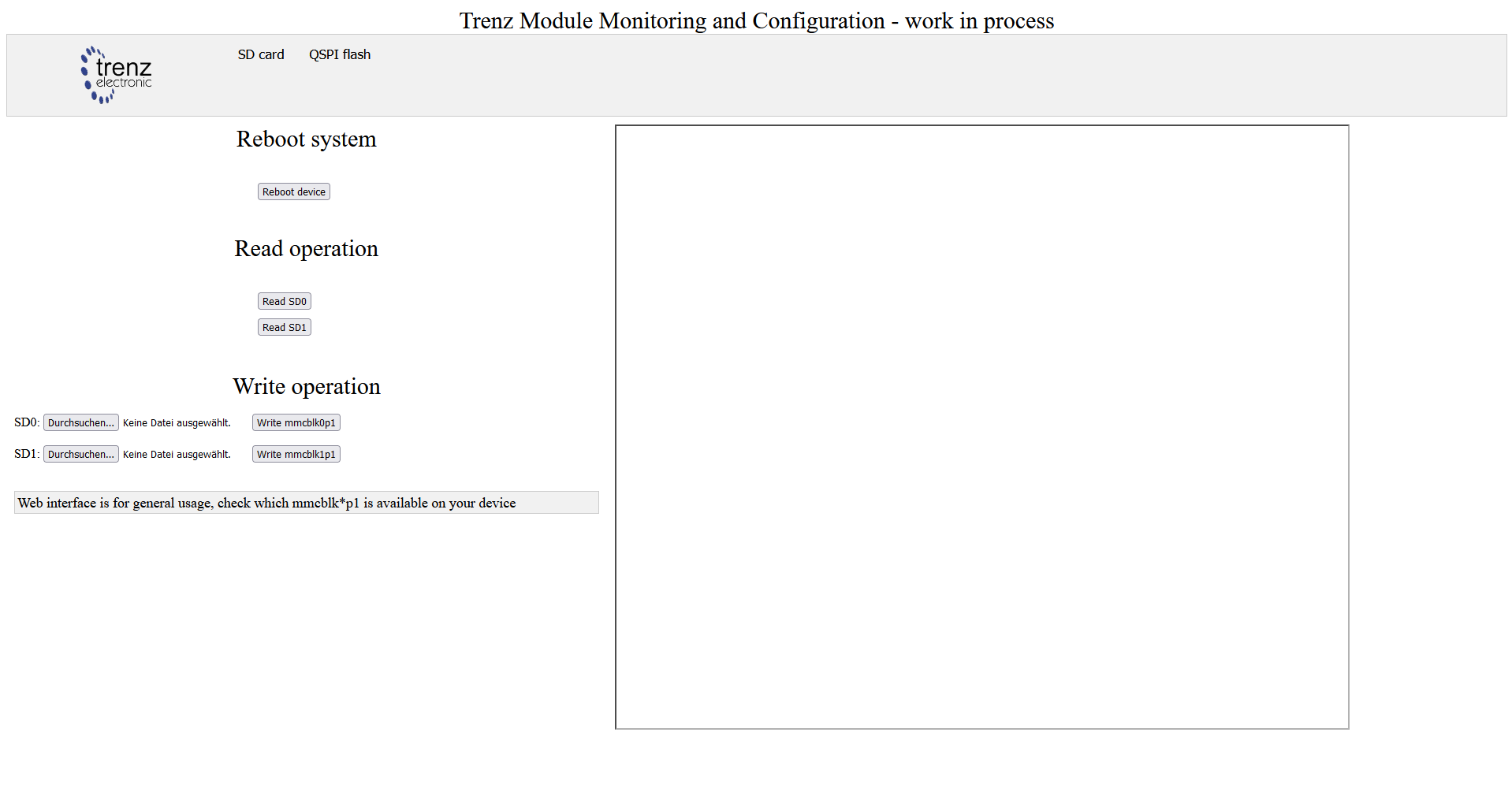
Startup Script
- If there is a start script named 'init.sh' on the SD card, it is loaded and executed shortly before the Linux boot process is completed.
- User bash code can be inserted on 'init.sh'
Monitoring input clock (25MHz)
- Open Vivado HW-Manager and add VIO signal to dashboard (*.ltx located on prebuilt folder)
changed Value from 25MHz CLK to unsigned. Note: Frequency Counter is inaccurate and displayed unit is Hz
Scroll Title anchor Figure_VHM title-alignment center title Vivado Hardware Manager 
userLEDs
- The user LEDs indicate a binary counter, which is reset by pressing one of the cross buttons
7-Segment LCD Display
- LCD is connected to counter
DIP-Switch
- Determines the reset start value from the binary counter of userLEDs
Notes
Document Revision History
| Expand | |||||||||||||||||||||||||||||||||||||||||||||||||||||||||||||||||||||
|---|---|---|---|---|---|---|---|---|---|---|---|---|---|---|---|---|---|---|---|---|---|---|---|---|---|---|---|---|---|---|---|---|---|---|---|---|---|---|---|---|---|---|---|---|---|---|---|---|---|---|---|---|---|---|---|---|---|---|---|---|---|---|---|---|---|---|---|---|---|
| |||||||||||||||||||||||||||||||||||||||||||||||||||||||||||||||||||||
|
| Scroll Only | ||
|---|---|---|
|
| Scroll pdf ignore | ||||||
|---|---|---|---|---|---|---|
|